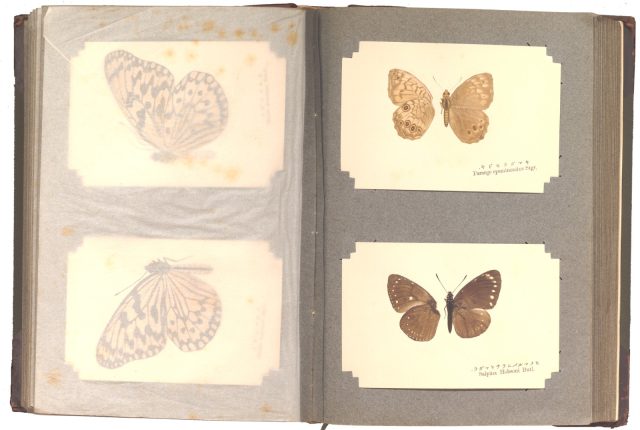
May 17, 2024
One-day conference
May 18, 2024
Public lecture on science
Workshop on flora and fauna on the Clark grounds
Organized by:
Rebecca Fenning Marschall; rfenning@humnet.ucla.edu
Anna Chen; achen@humnet.ucla.edu
Summary:
The early modern period was a hothouse for the study of physical things in the natural world, and for the collection and assembly of them in human-made physical spaces. In other periods, botanical samples were preserved by diarists in their journals, such as Poems and Riddles written by Mary Woodyeare Tibbits (ca. 1764–1840), and Pressed specimens of butterflies and moths (1905), compiled by Yasushi Nawa (1857–1926), which are both in the Clark Library’s collections. Nawa’s lepidochromic book showcases the technique of “printing butterflies,” or fixing the scales of their wings onto paper. Specimens of all sorts were admired for their variegated colors, curated in collections, and assembled into books. Birds were captured in aviaries for their sounds, or killed and prepared as specimens for display, study, and scientific descriptions. Plants were transported across oceans in terraria, and contained in plots and glasshouses.
Libraries were deeply implicated in these historical pursuits of the collection and classification of the contents of the natural world, as are modern libraries that now grapple with whether and how to preserve the nature that enters their collections. The interior-exterior division of libraries is a highly regulated boundary. Libraries strive tirelessly to seal the building envelope against the environmental conditions of the outdoors, as fluctuating temperature and humidity levels, mold spores, insects, rodents and natural disasters all threaten damage to their holdings. Libraries also capture books about nature on their shelves, as flora and fauna cohabitate on their grounds. At the Clark Library, Cooper hawks nest, feral cats roam, and roots of trees probe the ground in search of water.
What might we learn from these efforts to capture and to conserve nature, coupled with its potential to decompose or to invade environments?
Potential topics include, but are not limited to, the following:
Specimens
-Flora and fauna
-Mineralogy (fossils, rocks)
-Environments
Classification and identification
-Pursuing phenomena (amateur/professional collectors/travel)
-Organizing phenomena (grids, tables, naming, morphologies)
Natural history collections
-Books, drawers, gardens
Structures of Containment
-Terraria, herbaria, aviaries, menageries, cabinets, hot houses, gardens
We especially encourage submissions related to the Clark Library’s collections:
-English and Western European literature and history 1600–1900
-Fin-de-siècle popular culture, literature, & Oscar Wilde
-Modern book arts, fine printing, and the history of the book
-Montana and the American West 1750–1940
We invite abstracts for 15–20-minute papers from scholars in any discipline.
Please submit a 250-word proposal, and brief (2-page) CV, using this form:
https://forms.gle/YSj53Wuj9Bh65ebeA
Deadline extended to: October 15, 2023
Notification of acceptance: November 2023
Travel reimbursement and lodging support is provided by the Clark & Center.
The conference is free and open to the public; advance registration for attendees is required. Registration will open in early Spring 2024.
For information on the Clark & Center:
https://clarklibrary.ucla.edu/
https://www.1718.ucla.edu/
For more information on the Clark Library’s collecting areas:
https://clarklibrary.ucla.edu/collections/what-we-collect-and-why/
Please feel free to contact the conference organizers with any questions.

